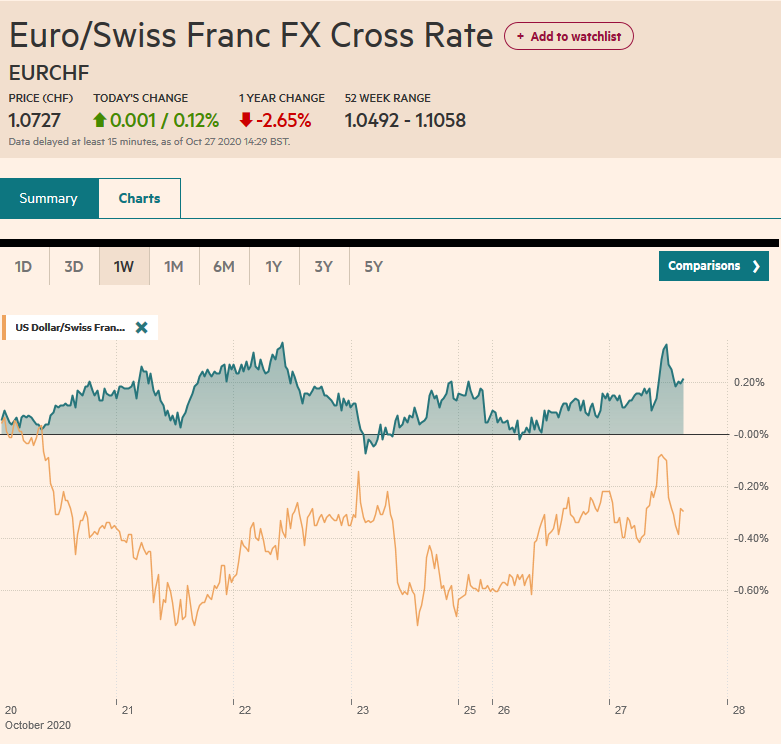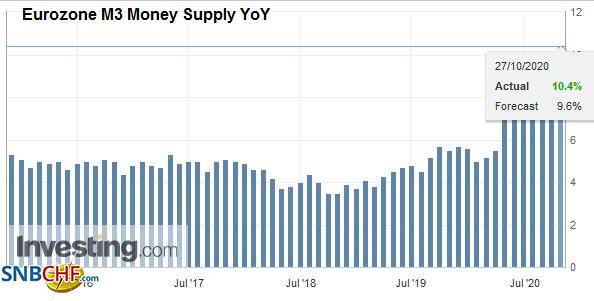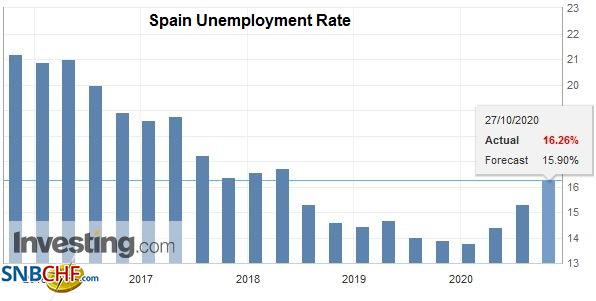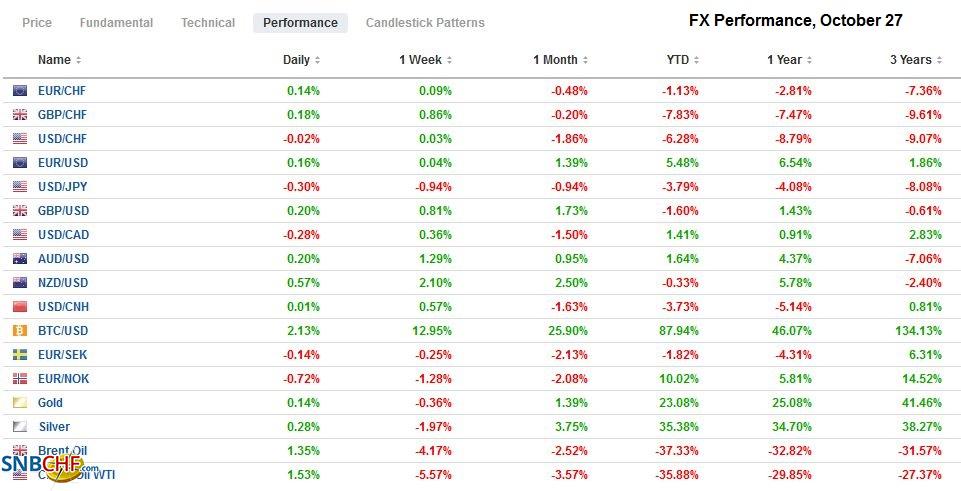Swiss Franc The Euro has risen by 0.12% to 1.0727 EUR/CHF and USD/CHF, October 27(see more posts on EUR/CHF, USD/CHF, ) Source: markets.ft.com - Click to enlarge FX Rates Overview: The surging pandemic sapped the risk-taking appetites as some investors hunker down for what could be a volatile period ahead. The S&P 500 lost nearly 3% at its lows before rebounding 1% in late dealings. However, the US’s fiscal stimulus remains highly likely even if not immediate, and more intensive trade talks between the UK and EU have already begun. The spread of the virus also means policymakers must be vigilant in their response, and many countries will need to extend their efforts. Equities in the Asia Pacific and Europe are mostly lower. Chinese and Indian markets were
Topics:
Marc Chandler considers the following as important: $CNY, 4) FX Trends, 4.) Marc to Market, Currency Movement, ECB, EUR/CHF, Featured, Mexico, newsletter, Turkey, USD, USD/CHF
This could be interesting, too:
RIA Team writes The Importance of Emergency Funds in Retirement Planning
Nachrichten Ticker - www.finanzen.ch writes Gesetzesvorschlag in Arizona: Wird Bitcoin bald zur Staatsreserve?
Nachrichten Ticker - www.finanzen.ch writes So bewegen sich Bitcoin & Co. heute
Nachrichten Ticker - www.finanzen.ch writes Aktueller Marktbericht zu Bitcoin & Co.
Swiss FrancThe Euro has risen by 0.12% to 1.0727 |
EUR/CHF and USD/CHF, October 27(see more posts on EUR/CHF, USD/CHF, ) Source: markets.ft.com - Click to enlarge |
FX RatesOverview: The surging pandemic sapped the risk-taking appetites as some investors hunker down for what could be a volatile period ahead. The S&P 500 lost nearly 3% at its lows before rebounding 1% in late dealings. However, the US’s fiscal stimulus remains highly likely even if not immediate, and more intensive trade talks between the UK and EU have already begun. The spread of the virus also means policymakers must be vigilant in their response, and many countries will need to extend their efforts. Equities in the Asia Pacific and Europe are mostly lower. Chinese and Indian markets were more resilient, while the Antipodeans experienced a 1.7% slide. Europe’s Dow Jones Stoxx 600 is off for the ninth session in the past 11 for around a 5% pullback. The S&P is seen little changed. It surpassed the 50% retracement of the rally off last month’s lows (~3379), and the next retracement is near 3339. Bonds markets are mostly quiet after Asia Pacific markets played a little catch-up after yesterday’s yields softened in the US and Europe. The US benchmark 10-year note yield is around 0.80%. The dollar is mixed, but mostly little changed. The euro slipped below $1.18 but is back above it in the European morning. The dollar remains below JPY105.00, Many Asian emerging market currencies edged higher, the Chinese yuan is a little softer. The Turkish lira remains under pressure, and the dollar rose to new a new record above TRY8.15. Gold is little changed, holding above $1900, while December WTI is firm but holding mostly below $39 a barrel. |
FX Performance, October 27 |
Asia Pacific
There were three pieces of data out in the notable region. First, industrial profits slowed in China in September. The year-over-year pace slowed to 10.1% from 19.1% in the year through August. For the first nine months of the year, profits are still off around 2.4%. Second, South Korea’s economy expanded by a stronger than expected 1.9% in Q3 following a 3.2% contraction in Q2. The year-over-year decline narrowed to 1.3% from 2.1%. Third, New Zealand’s September trade figures show the 12-month trade surplus reached a six-year high (~NZD$1.71 bln). Two highlights lie ahead: The BOJ meeting and possible lower economic assessment, and Australia’s quarterly inflation report ahead of next week’s central bank meeting due to first thing tomorrow.
China appears to have boosted imports from the US last month. Some reports estimate it at nearly $10 bln of oil, soy, and auto parts. Many private observers figures are far from the US’s estimate at the end of last week, suggesting China had met around 70% of its purchase agreements. Meanwhile, the US is going forward with new weapon sales to Taiwan. The US has approved a $2.4 bln package of land-based anti-ship missiles. These measures enjoy bipartisan support.
The dollar poked above JPY105 in North America yesterday but did not draw any follow-through buying. The JPY105 level remains intact today, perhaps helped by the expiry of a $1.8 bln option struck there. Initial support is seen near JPY104.55, though last week’s low was nearer JPY104.35. The Australian dollar is quietly inside yesterday’s range, which itself was inside the pre-weekend range (~$0.7100-$0.7160). A break of $0.7100 could signal a re-test on last week’s low near $0.7020. The PBOC set the dollar’s reference rate at CNY6.6989, which was a little firmer than the models expected. It is the fourth consecutive day that the dollar has risen above the previous session’s high. The four-day dollar advance is the longest since May. We initially anticipated a move to CNY6.72. The dollar rose to nearly CNY6.7180 today. The PBOC announced it was removing the “counter-cyclical element” in setting the reference rate. This was a bit of a black box that seemed to give authorities greater say. The removal of it could make it more transparent.
EuropeThe ECB meeting is the highlight of the week. Although no new initiatives are likely to be unveiled, the groundwork, primarily in word cues, for an expansion of its bond purchases, and perhaps other measures as well, is expected. Today, September’s money supply was reported. M3 growth accelerated to 10.4% in the year through September, nearly a percentage point faster than in August. |
Eurozone M3 Money Supply YoY, September 2020(see more posts on Eurozone M3 Money Supply, ) Source: investing.com - Click to enlarge |
| Loan growth to households ticked up to 3.1% from 3.0%, while loans to businesses maintained a 7.1% pace. However, the ECB also reported that banks tightened their lending standards in Q3 and banks expect to be more restrictive in Q4 amid concerns about the economic outlook and uncertainties around the extension of fiscal measures. The ECB could try to counter this by a new long-term loan program (TLTRO) with a rate as low as minus 100 bp. |
Spain Unemployment Rate, Q3 2020(see more posts on Spain Unemployment Rate, ) Source: investing.com - Click to enlarge |
The UK will report the CBI retail sales shortly, and it is expected to have weakened from the 11 reading in September. The BOE meets next week and is widely expected to ease policy, with new Gilt purchases expected and a possible cut in the base rate to zero from 10 bp. UK-EU trade talks have intensified, which amounts to daily meetings, according to reports. We continue to remain concerned that even if a deal is struck, the disruption will be great. The latest report suggests that important software needed at the border will not be ready in time, and this will add to anticipated delays.
Turkey is finding itself increasingly at odds with Europe and the US. It expands its search for gas in waters that Greece and the EU claim. It tested a Russian-made anti-aircraft defense system that will likely spur sanctions. It has criticized France and the French President personally, and France has withdrawn its ambassador to Turkey. It is on the opposite side of Russia in Armenia and Azerbaijan conflict. Its decision not to raise the one-week repo rate last week (though it did lift the late loan window, which does raise funding costs in the current environment) has seen the lira slide by around 4.2% to a new record low. This reinforces a vicious cycle of the weaker lira, price pressures, and the weak, politicized policy response.
The euro has been confined to less than a half of a cent range today. It dipped below $1.18 in early European trade and bounced back to almost $1.1820. There are nearly 1.2 bln euros in options struck between $1.1800 and $1.1805 that expire today, and the market may work through whatever defense is left. A break of the $1.1780 area could spur a test on last week’s low near $1.1700. There may be little incentives to extend long euro positions ahead of what is expected to be a dovish ECB. Sterling reached a high last week a little above $1.3175 and slipped below $1.30 yesterday for the first time since the middle of last week. It has held above $1.30 today, but barely so. A move above $1.3050 would help stabilize the tone. The euro-sterling cross is little changed near GBP0.9070.
AmericaThe US sees August’s house prices, September durable goods orders, the October Conference Board’s consumer confidence, and the Richmond Fed’s manufacturing survey. Outside of headline risk, the market is looking beyond these high-frequency data points. Tomorrow’s trade and inventory figures will solidify forecasts for Q3 GDP due Thursday morning. On a quarterly basis, the US economy contracted by around 9% in Q2 and is expected to have rebounded by about 7% in Q3. Most economists are anticipating a dramatic slowdown in Q4 to about a 1.25% quarterly pace. |
U.S. House Price Index YoY, August 2020(see more posts on U.S. House Price Index, ) Source: investing.com - Click to enlarge |
The Bank of Canada meets tomorrow. It continues to buy CAD5 bln a week of government bonds, and its purchases appear to have been focused on newly issued bonds for liquidity purposes. Its share of the newly issued market is seen to be near a third and could rise to 50%. The distortion that it may cause could prompt the Bank of Canada to alter its approach, even if not yet. Under yield curve control, it might not have to buy as many bonds.
Mexico reported a record trade surplus in recent months. This, coupled with strong worker remittances and the attractiveness of Mexico real and nominal interest rates for global investors, helped the peso recover around half of what it lost earlier this year. The September trade figure will be reported today and are expected to show the surplus falling to around $3.6 bln from $6.1 bln in August. Ahead of the weekend, it will report Q3 GDP. It is expected to have expanded by almost 12% after a 17.1% contraction in Q2.
The US dollar jumped to CAD1.3225 yesterday amid the risk-off push, which often weighs disproportionately on the Canadian dollar. The greenback is consolidating in about a 20-tick range on either side of CAD1.3190. Initial support in North America is seen near CAD1.3160. The US dollar spiked to a little beyond MXN21.13 was sold into, and it finished near MXN20.9350 yesterday. It is a little changed before the start of the North American session. It recorded a low last week by MXN20.8550, just above the September low (~MXN20.8450). A consolidative session is likely as fresh incentives are awaited.
Graphs and additional information on Swiss Franc by the snbchf team.
Tags: #USD,$CNY,Currency Movement,ECB,EUR/CHF,Featured,Mexico,newsletter,Turkey,USD/CHF









